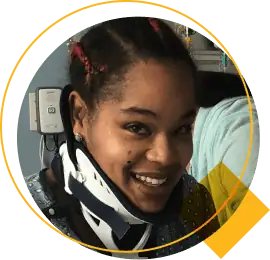Home / Nexus Champions / Brittany Morris


Nexus Champion
Brittany Morris
Co-occurring Conditions:
- Cervical spinal cord injury
- Tracheostomy
When Brittany Morris was admitted to Nexus Children’s Hospital in Shenandoah, she was facing one of the most difficult moments of her life. After a traumatic spinal cord injury, she arrived with a tracheostomy and a cervical collar, and required total assistance for nearly all activities of daily living — from bed mobility to personal care. She was unable to sit upright for more than a few minutes and had almost no control of her trunk.
“She was dependent upon others for everything,” said Doreen Garcia, her occupational therapist. “Transfers, grooming, dressing, feeding — she needed two-person assistance and specialized equipment just to get through her day. But even from the beginning, Brittany had this spark. She wanted to get better. She showed up every day.”
According to Brittany, her desire to return to the role of “mom” was a huge component of her motivation. “I was determined to let nothing keep me from taking care of my twins,” Brittany said.
With that determination, she began what would become a life-changing journey. Nexus’ interdisciplinary team began building a plan tailored to her needs, goals, and pace. “The first big milestone was tolerance of sitting upright,” Garcia said. “That might not sound like much to most people, but for Brittany, sitting up in a wheelchair for even an hour was a huge win.”
Within a month, Brittany was sitting upright in her wheelchair for more than three hours at a time — a major leap from her early tolerance. From there, her progress began to build. Two months into her stay, Brittany began trialing sliding board transfers. “That was a turning point,” said Garcia. “She had gone from needing total assistance to initiating her own transfers with minimal support. It was a sign of how far she had come, physically and mentally.”
Over time, she also regained the ability to feed herself and perform oral hygiene without adaptive equipment, requiring only setup assistance. She mastered the use of her power wheelchair and became fully independent in cueing caregivers or family when she needed support. “That ability to direct her care—to advocate for herself — that’s huge,” said Garcia. “It gave her back a sense of control.”
Brittany’s confidence grew alongside her physical strength. “The thing I remember most is how engaged she became in therapy,” Garcia continued. “She was always asking, ‘What’s next? What can I work on today?’ She kept pushing herself, even on hard days. And there were hard days.”
Despite the challenges, Brittany never lost her sense of humor or her connection with those around her. “She made people laugh. She made connections with staff. She became part of the community here,” Garcia said. “She showed so much heart.”
On December 19, 2019, Brittany was discharged to return home with her mother and children. Though she still required a Hoyer lift for transfers and maximum assistance for dressing and bed mobility, she left Nexus with a foundation of independence that she could continue to build on. “She walked out of here figuratively standing tall,” Garcia said. “Not just because of what she accomplished physically, but because of the spirit she rediscovered in herself.”
Today, Brittany continues to thrive at home. Her journey toward independence didn’t end at Nexus — it evolved. “There’s never really an end to the journey with this type of disability,” she said. “But I have a life again. Nexus gave me the tools to keep going.”
Her story is a testament to the power of perseverance. Following her stay at Nexus, she continued therapy in an outpatient setting. She returned to college and graduated with a degree in occupational health and safety, learned to drive and received her driver’s license, and began independently caring for her children again.
Brittany now volunteers at post-acute care settings, where she shares her story with other spinal cord injury survivors. “I tell others to never accept no for an answer. Always be willing to take risks. It might be scary at first, but it’s possible. You’ve just got to believe you can do it.”
Occupational therapist
Led by an interdisciplinary team of doctors and rehabilitation experts, the Rise Program helps patients recovering from brain injury, spinal cord injury, stroke, and other neurological conditions transition from intensive care to post-acute neurorehabilitation and, finally, home.
